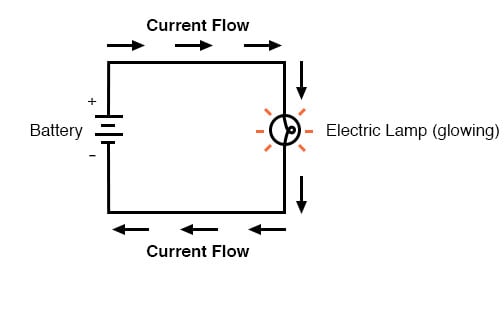-
Notifications
You must be signed in to change notification settings - Fork 0
Core Electrical Concepts
An electric circuit is formed when a conductive path is created to allow electric charge to continuously move. This continuous movement of electric charge through the conductors of a circuit is called a current , and it is often referred to in terms of “flow,” just like the flow of a liquid through a hollow pipe.
Electric current and Electric charge are the two most fundamental electrical quantities in any electric circuit. The major difference between current and charge is that the electric charge is the subatomic property of all the materials in nature, while the electric current is the direct flow of electric charge in an electric circuit.
Electric charge or simply charge is the property of subatomic particles of substances by virtue of which the substances exhibit the electrical behavior. It is denoted by symbol ‘Q’ or ‘q’ and is measured in coulombs (C).
Electric current is nothing but the directed flow of electric charge (more specifically electrons). Mathematically, the time rate of flow of electrons in a conductor is called the electric current, and it is denoted by symbol ‘i’ or ‘I’ i.e.
Where, ‘i’ is used to denote time varying current, whereas ‘I’ is used to denoted constant current. The above relation shows that the electric current is the function of electric charge in time domain. The electric current is measured in amperes (A).
The force motivating charge carriers to “flow” in a circuit is called voltage. Voltage is a specific measure of potential energy that is always relative between two points. When we speak of a certain amount of voltage being present in a circuit, we are referring to the measurement of how much potential energy exists to move charge carriers from one particular point in that circuit to another particular point. Without reference to two particular points, the term “voltage” has no meaning. It is measured in volts, which, technically, is the potential energy difference between two points that will impart one joule of energy per coulomb of charge that passes through it. The unit "volt" is named after the Italian physicist Alessandro Volta who invented what is considered the first chemical battery. Voltage is represented in equations and schematics by the letter "V".
Current tends to move through the conductors with some degree of friction, or opposition to motion. This opposition to motion is more properly called resistance. The amount of current in a circuit depends on the amount of voltage and the amount of resistance in the circuit to oppose current flow.
Just like voltage, resistance is a quantity relative between two points. For this reason, the quantities of voltage and resistance are often stated as being “between” or “across” two points in a circuit.
Consider two water tanks, one with a narrow pipe and one with a wider pipe.
It stands to reason that we can't fit as much volume through a narrow pipe than a wider one at the same pressure. This is resistance. The narrow pipe "resists" the flow of water through it even though the water is at the same pressure as the tank with the wider pipe.
In electrical terms, this is represented by two circuits with equal voltages and different resistances. The circuit with the higher resistance will allow less charge to flow, meaning the circuit with higher resistance has less current flowing through it.
Here are some videos that can help you understand more regarding these topics:
Ohm’s principal discovery was that the amount of electric current through a metal conductor in a circuit is directly proportional to the voltage impressed across it, for any given temperature. Ohm expressed his discovery in the form of a simple equation, describing how voltage, current, and resistance interrelate:
In this algebraic expression, voltage (E) is equal to current (I) multiplied by resistance (R). Using algebra techniques, we can manipulate this equation into two variations, solving for I and R, respectively:
In the above circuit, there is only one source of voltage (the battery, on the left) and only one source of resistance to current (the lamp, on the right). This makes it very easy to apply Ohm’s Law. If we know the values of any two of the three quantities (voltage, current, and resistance) in this circuit, we can use Ohm’s Law to determine the third.
In this example, we will calculate the amount of current (I) in a circuit, given values of voltage (E) and resistance (R):
What is the amount of current (I) in this circuit?
In this second example, we will calculate the amount of resistance (R) in a circuit, given values of voltage (E) and current (I):
What is the amount of resistance (R) offered by the lamp?
Resistivity is a property that describes the extent to which a material opposes the flow of electric current through it. It is a property of the material itself (not the size or shape of the sample), usually depends on temperature and may depend on other quantities such as pressure.
The resistance of a piece of material depends on its resistivity and also its size and shape. The resistance R of a wire with cross sectional area A and length L (Figure 1), made from a material of resistivity ρ ('rho'), is given by the equation:
Created and maintained by Open Horizon® under the GNU AGPLv3 licence. Visit the full repository at https://github.com/openhorizonrobotics/ece-1.
test





